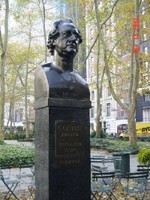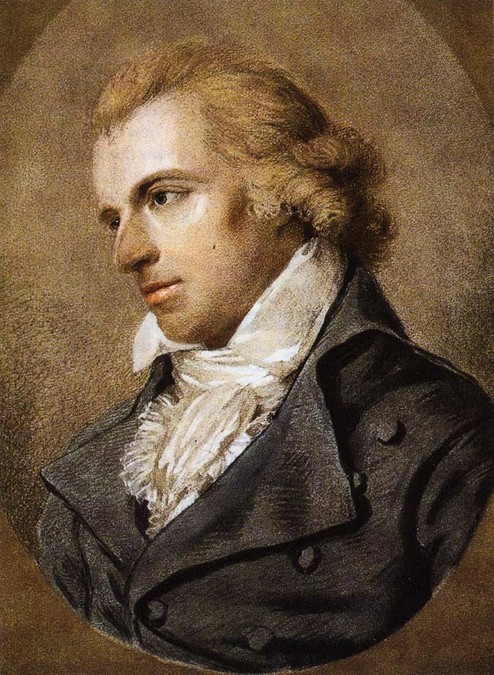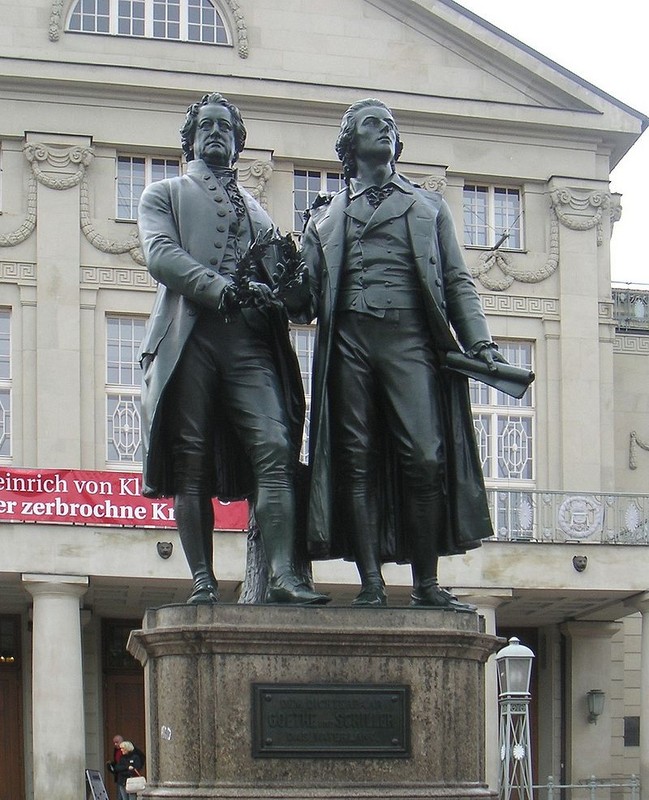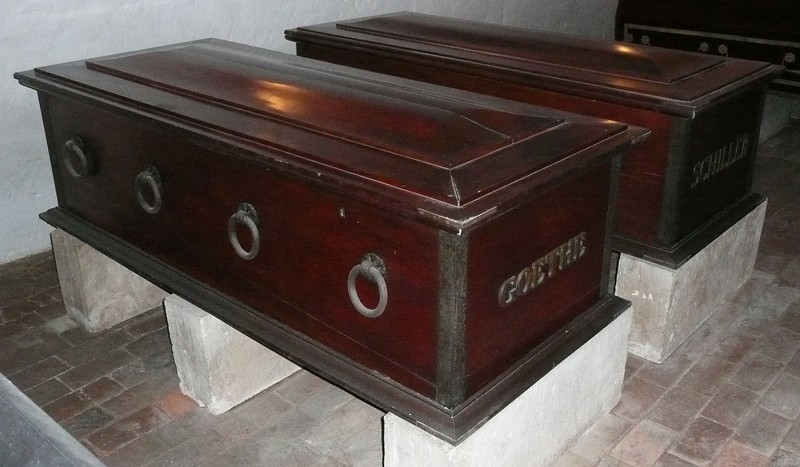Johann Wolfgang von Goethe Statue
Introduction
Author-Uploaded Audio
00:00 / 00:00
Reading of Wanderers Nachtlied by Goethe
Text-to-speech Audio
Images
Goethe statue in Bryant Park

Goethe in 1775

Goethe at age 38, painted by Angelica Kaufmann (1787)

Goethe in 1828 by Joseph Karl Stieler
.jpg)
Friedrich Schiller (1794) by Ludovike Simanowiz

Goethe-Schiller Monument (1857), Weimar

Coffins of Goethe and Schiller

Backstory and Context
Author-Uploaded Audio
00:00 / 00:00
Section 1 of The Sorrows of Young Werter
Text-to-speech Audio
Johann Wolfgang von Goethe was born August 28, 1749 to Johann Kaspar Goethe and Catharina Elisabeth (Textor) Goethe. Johann Goethe was a lawyer and had been able to purchase the honorific title “True Imperial Councillor” and retire before his marriage. Johann Wolfgang Goethe had one surviving sister, Cornelia, who was a year younger than him and their father dedicated much of his time educating the children.
Goethe was educated in Greek, Latin, French, and Italian by a very young age and in 1765 he enrolled to study law at Leipzig to follow the wishes of his father. His time in Leipzig proved more influential to his ideas of literature and culture rather than his study of law. He was introduced to the stye of neoclassicism (through the work of Johann Cristoph Gottsched), which Goethe heavily criticized, as well as the artistic style of his drawing instructor Adam Freidrich Oeser which emphasized beauty as simplicity and art as shaped by history and process. It was also during this time that Goethe had his first of many major romantic affairs, falling in love with Anne C. Schoenkopf. Much of his poetry over the course of his life stemmed from a cycle of romantic affairs, starting with his first collection of poems titled Annette based on his love for Schoenkopf. It is also thought that he often frequented the restaurant Auerbacks Keller which contained paintings depicting the Faust legend and was featured in Goethe’s later work, Faust.
While studying at Leipzig, Goethe fell ill with tuberculosis and had to return home for a two-year convalescence. He returned to his law degree in Strassburg in 1770. There he came in contact with the Strum and Drang literary movement and met Johann Gottfried Herder who encouraged Goethe to read more classics, what Goethe called his first literary “awakening.” Inspired by the Enlightenment and American Revolution, the Strum and Drang movement focused on natural feeling rather than rationalism and wanted political freedom. Herder is known as advancing the concept of nationalism and the idea of a “national poet” and influenced by Kant, advocated for a “universal history” of every historical, cultural, political, and scientific event. Herder’s ideas greatly influenced Goethe and Goethe is considered a national poet for Germany. From Herder Goethe also got the idea that poetry was the essential language of man and that folk poetry was the most connected to the essence of a people; this inspired him to collect folksongs into Europe’s first anthology of such pieces. During this period in Strassburg Goethe also fell in love with Friedericke Brion, which inspired a new set of poetry, such as Sesenheimer Lieder written 1770-1771.
Goethe finished his law degree in 1771 and opened a practice in Frankfurt. He soon moved to Darmstadt and practiced progressive law. While he practiced law, he continued to write poetry and plays. Inspired by European Romantics and his new-found love of Shakespeare, Goethe wrote his first major play in 1771. Götz von Berlichingen with the Iron Hand mixed the narrative ballad, capturing personal experience, and drama together to change the traditional structure of theatre. This was the first of his written works that brought him national recognition. The following year Goethe received international fame with the publication of The Sorrows of Young Wether. The novel is loosely based on events in Goethe’s life, namely a love triangle between himself, Charlotte Buff, and her fiancé Johan Christian Kestner, and while Goethe did not himself commit suicide his friend Karl Wilhelm Jerusalem had killed himself in 1772 at the age of 25, reflected in the end of Werther’s story. The novel received a wide range of reactions, but solidified Goethe’s path as a literary figure instead of a lawyer. Later in life Goethe expressed dissatisfaction with Werther because he had moved away from the sentimental romanticism expressed in the book, but there is no doubt the impact the work had on his life and career. Literary scholars see Werther as the start of three new genres—the novel of interiority, the novel of the outsides, and the suicide novel—and a contribution to the emergence of existentialism. Reputedly the novel created a wave of copycat suicides and young men dressing in the style of the protagonist, although that has been disputed by some scholars.
With the success of Werther Goethe was invited to the court of Duke Karl August at Weimar. Weimar was a small state within the Holy Roman Empire and the Duke was only eighteen, but it was experiencing a cultural Revolution as the hands of the Duke’s mother, Duchess Anna Amalia. He was an advisor and counselor to Duke Karl August and was involved with a variety of issues in the state from mining and finance to the theater and foreign policy. Weimar would remain his home for the rest of his life and he continued to advance up the ranks in the court becoming Finance Minister in 1782, Privy Councillar in 1804, and Minister of State in 1813. His duties, such as overseeing mining operations for the state, introduced him to natural and geological studies that affected his later research and writing. He studied anatomy, botany, and geology, among other things, and produced several scientific works.
Personal and world affairs continued to affect his writings. Goethe took a sudden trip to Italy and stayed for two years (1786-1788). His introduction to the Renaissance and classic ancient texts influenced his works, most notably Iphigenia in Tauris which he wrote during the trip. Taking Euripides’ Iphigenia in Aulis as inspiration, a text in which Agamemnon must sacrifice his eldest daughter to appease the goddess Artemis, Goethe turned his version into one that promotes individual consciousness over the power of the gods. He emphasizes the heart (feelings) as the main organ through which people understand their world, rather than the brain (rationalism) and makes the heart the core of understanding and conscious. The work also offers criticism of “civilization” saying that that there was no essential difference between civilized man and barbarian. Within the context of the Enlightenment the play emphasizes personal freedom with the evolution of the main character and promotes feminism with the role of the leading female character. Also on his Italian trip, Goethe had an affair with Faustina di Giovanni which led to another series of love poetry.
Goethe returned to Weimar in June 1788 and a couple of weeks later met Christiane Vulpius. This was the closest and most permanent romance of his life. Goethe and Vulpius lived out of wedlock for many years and had five children together (only their first-born son August survived). This cemented Goethe’s reputation for immorality, a reputation from both his previous romances and many of his written works. Goethe finally married Vulpius in October 1806 and they were married about ten years. Her death on June 6, 1816 devastated Goethe.
After his return from Italy, Goethe entered a period of classicism influenced very strongly by the events of the French Revolution and his partnership with Friedrich Schiller. Goethe wrote several plays and novels set against the events of the Revolution between 1791 and 1803 that emphasized personal responsibility and stability against the political action and instability in France. Goethe saw part of the French Revolution firsthand as advisor to Karl August; August fought in the War of the First Coalition against France and Goethe traveled with him to the front lines. Based on his experiences Goethe wrote Campaign in France, 1792 which both glorified himself as a hero and spoke against war, an early version of the genre of antiwar literature seen in later centuries. Soon after this experience, Goethe connected with Friedrich Schiller in 1794 and formed a close friendship that would mark an important era in German literature. The two writers had met previously without much note, but between 1794 and 1805 they bonded and published many literary works that are considered the heart of German literature and Weimar Classicism. In many ways their writing was a reaction to the French Revolution—Schiller argued that citizens were not yet ready for a modern republic and needed more moral and intellectual skills for the new government and Goethe emphasized personal growth and evolution. Many of their ideas pushed against earlier Enlightenment ideas such as the social contract and ideas of the mechanistic man. Both writers were prolific during this time, until Schiller died in 1805.
While Goethe is most known for his literary accomplishments, he believed that his greatest legacy was his scientific work. Due to his work in Weimar he was exposed to a variety of scientific fields, and while never being a full scholar in any of them, published several scientific works and theories. His theory in botany, partially developed during his stay in Italy, countered the prevailing work by Linnaeus who categorized species of plants based on external characteristics. Goethe’s idea of “morphology” focused instead on the natural observation of growth and change over time in plants and natural creatures. He argues that nature was not static and metamorphosis was a part of each living thing; instead of classifying a plant on one static part of its growth, instead taxonomy should classify each stage of each part of the plant. This theory also introduced Goethe’s concept of “polarity” as tension between creativity (or natural growth) and structural limitation. In a larger context, he saw this tension as allowing for creative productivity. Goethe believed that he had discovered a universal law of botany that could explain all plant life—modern botanists connect his early theories with later studies of genetics and evolution in the 19th and 20th centuries.
Goethe’s main scientific study was on light and colors. He challenged Newton’s theory of optics because his experiments used artificial light and Goethe argued that they could not assume natural light acted the same. Goethe preferred natural observation and saw that color appeared in the tension between light and dark (on the edges of shadows) and that color depended on the context of the observer. He observed a double color spectrum through natural observation of how color happened in the natural environment. He introduced some of these theories in Contributions to Optics (1971-2), but his big work was Theory of Color in 1810. His attempts were not widely received at the time but did gain more notice by scientists later on.
Goethe’s last major work, and a play that he worked on his entire life, was Faust. Influenced by the legend of Faust who made a pact with the Devil to acquire knowledge, Goethe adapted the story into a tragic play with a slightly different plotline. He published different phases of the work over the course of his career but did not finish it in its entirely until 1831. When he finished this 60-year endeavor he did not publish it, but put it away to be published after his death. Goethe died on March 22, 1832 and Faust was published posthumously. He is buried in the Ducal Vault of Weimar’s Historical Cemetery, side-by-side with Schiller.
Cite This Entry
Thompson, Kathleen. "Johann Wolfgang von Goethe Statue." Clio: Your Guide to History. October 28, 2020. Accessed March 23, 2025. https://theclio.com/entry/21864/tour/6
Sources
Adler, Jeremy. Johann Wolfgang Von Goethe. Reaktion Books, Limited, 2020.
Jensen, Anthony K. “Johann Wolfgang von Goethe (1749-1832).” Internet Encyclopedia of Philosophy. Accessed October 28, 2020. https://iep.utm.edu/goethe/.
“Johann Wolfgang von Goethe.” Academy of American Poets. Accessed October 28, 2020. https://poets.org/poet/johann-wolfgang-von-goethe.
"Johann Wolfgang von Goethe." Bryant Park. Accessed October 28, 2020. https://www.nycgovparks.org/parks/bryant-park/monuments/592.
"Johann Wolfgang von Goethe." Wikipedia. Accessed October 28, 2020.https://en.wikipedia.org/wiki/Johann_Wolfgang_von_Goethe.
"Johann Wolfgang von Goethe." Wikipedia. Accessed October 28, 2020.https://en.wikipedia.org/wiki/Johann_Wolfgang_von_Goethe.
"Johann Wolfgang von Goethe." Wikipedia. Accessed October 28, 2020.https://en.wikipedia.org/wiki/Johann_Wolfgang_von_Goethe.
"Friedrich Schiller." Wikipedia. Accessed October 28, 2020. https://en.wikipedia.org/wiki/Friedrich_Schiller.
"Friedrich Schiller." Wikipedia. Accessed October 28, 2020. https://en.wikipedia.org/wiki/Friedrich_Schiller.
"Johann Wolfgang von Goethe." Wikipedia. Accessed October 28, 2020.https://en.wikipedia.org/wiki/Johann_Wolfgang_von_Goethe.

